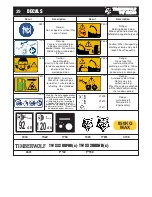
TIMBERWOLF
TW SX200
19
1. Storage and transport
- Batteries are filled with acid.
- Always store and transport batteries upright
and prevent from tilting so that no acid can
escape.
- Store in a cool and dry place.
- Do not remove the protective cap from the
positive terminal.
- Run a FIFO (first in-first out)warehouse
management system.
2. Initial operation
- The batteries are filled with acid at a density of
1.28g/ml during the manufacturing process and
are ready for use.
- Recharge in case of insufficient starting power
(cf. section 4).
3. Installation in the vehicle and removal from
the vehicle
- Switch off the engine and all electrical
equipment.
- When removing, disconnect the negative
terminal first.
- Avoid short circuits caused by tools, for example.
- Remove any foreign body from the battery tray,
and clamp battery tightly after installation.
- Clean the terminals and clamps, and lubricate
slightly with battery grease.
- When installing, first connect the positive
terminal, and check the terminal clamps for
tight fit.
- After having fitted the battery in the vehicle,
remove the protective cap from the positive
terminal, and place it on the terminal of the
replaced battery in order to prevent short
circuits and possible sparks.
- Use parts from the replaced battery, such as
the terminal covers, elbows, vent pipe
connection and terminal holders (where
applicable); use available or supplied filler caps.
- Leave at least one vent open, otherwise there
is a danger of explosion. This also applies
when old batteries are returned.
4. Charging
- Remove the battery from the vehicle;
disconnect the lead of the negative terminal first.
- Ensure good ventilation.
- Use suitable direct current chargers only.
- Connect the positive terminal of the battery to
the positive output of the charger. Connect the
negative terminal accordingly.
- Switch on the charger only after the battery has
beenconnected, and switch off the charger first
after charging has been completed.
- Charging current-recommendation: 1/10
ampere of the battery capacity Ah.
- Use a charger with a constant charging voltage
of 14.4v for re-charging.
- If the acid temperature rises above 55
o
Celsuis,
stop charging.
- The battery is fully charged when the charging
voltage has stopped rising for two hours.
5. Maintenance
- Keep the battery clean and dry.
- Use a moist anti-static cloth only to wipe the
battery, otherwise there is a danger of
explosion.
- Do not open the battery.
- Recharge in case of insufficient starting power
(cf. section 4).
6. jump Starting
- Use the standardised jumper cable in
compliance with DIN 72553 only, and follow the
operating instructions.
- Use batteries of the same nominal voltage only.
- Switch off the engines of both vehicles.
- First connect the two positive terminals (1) and
(2), then connect the
negative terminal of the
charged battery (3) to a
metal part (4) of the
vehicle requiring
assistance away from the battery.
- Start the engine of the vehicle providing
assistance, then start the engine of the vehicle
requiring assistance for a maximum of 15
seconds.
- Disconnect the cables in reverse sequence
(4-3-2-1).
7. Taking the battery out of service
- Charge the battery; store in a cool place or in
the vehicle with the negative terminal
disconnected.
- Check the battery state of charge at regular
intervals, and correct by recharging when
necessary (cf. section 4).
(1)
(2)
(3)
(4)
12v
12v
BATTERY SAFETY INFORMATION...cont.
SERVICE INSTRUCTIONS
Summary of Contents for TW SX200
Page 28: ...TIMBERWOLF TW SX200 27 IDENTIFICATION PLATE EXAMPLE...
Page 36: ...Blank page...
















































